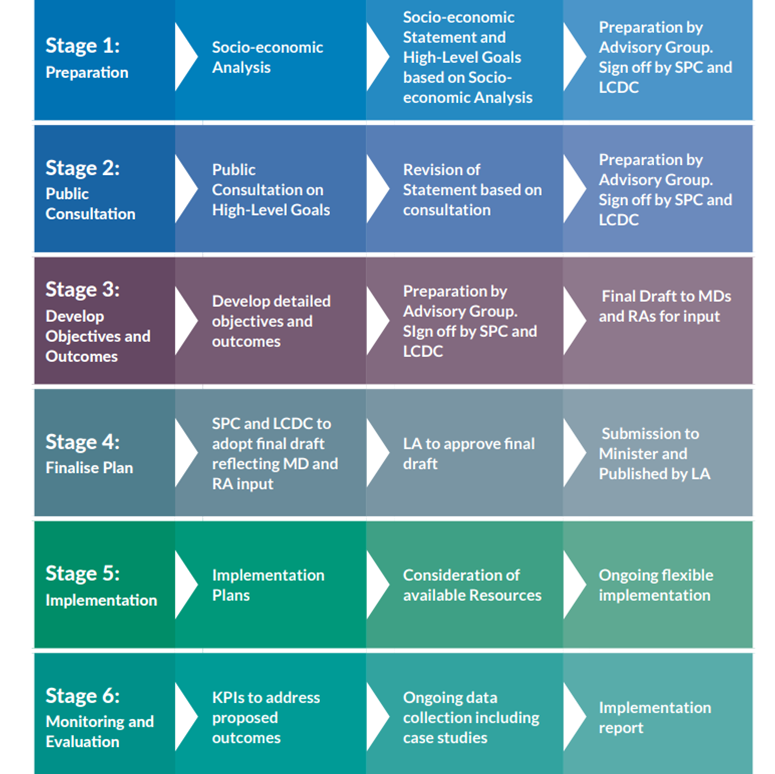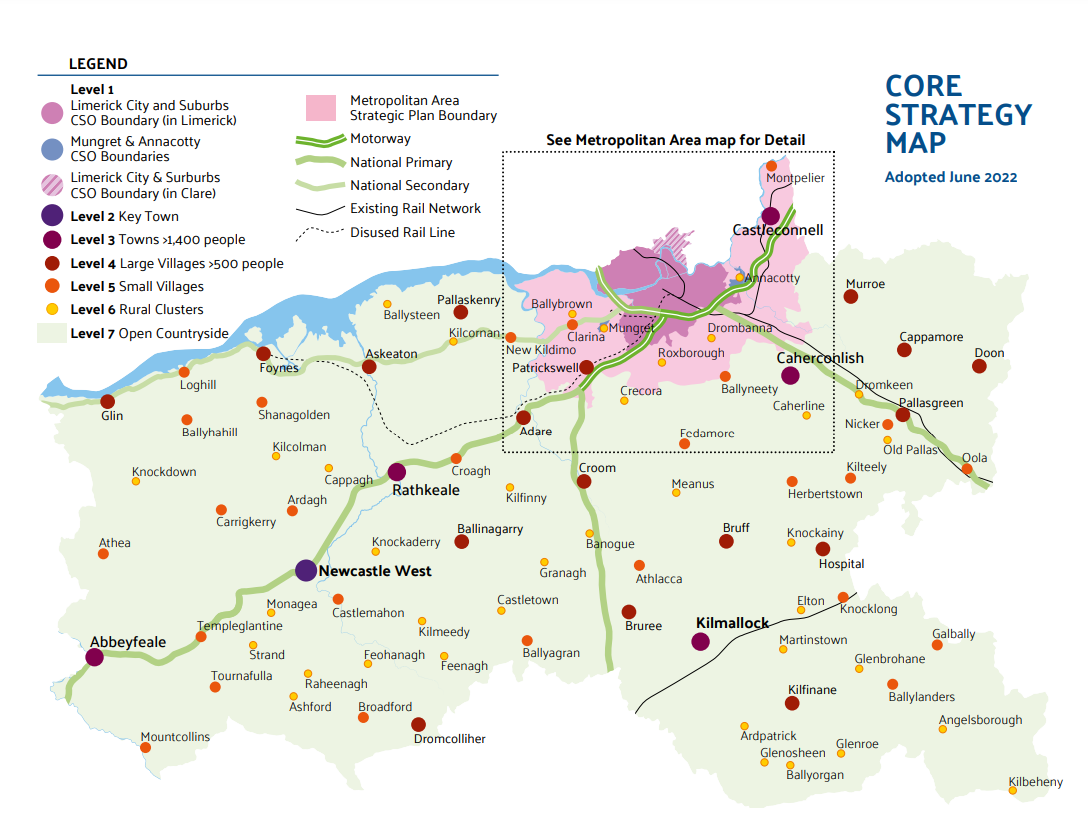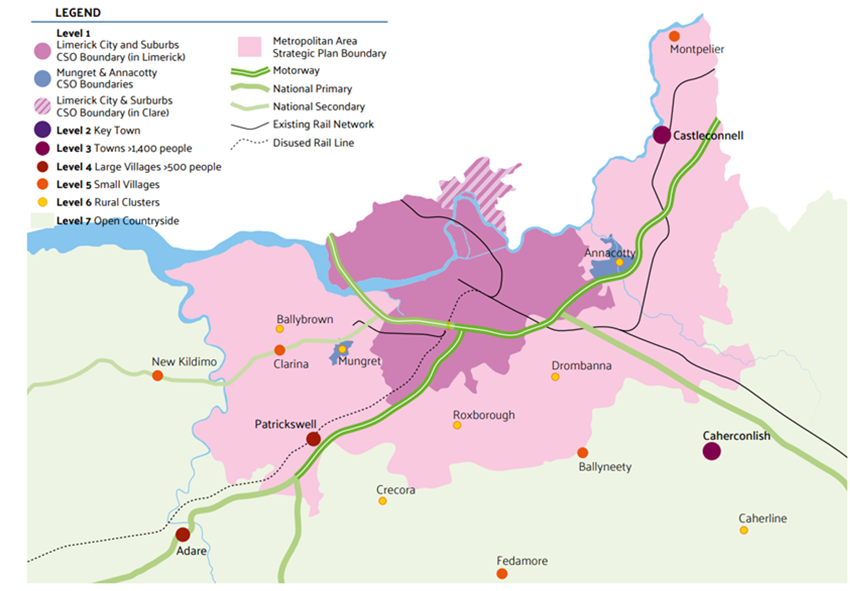Chapter 1- Introduction
1.1 Purpose of the LECP
The purpose of the LECP, as set out in the Local Economic and Community Plan (LECP) Guidelines (2021) is “to set out, for a six-year period, the objectives and actions needed to promote and support the economic development and the local and community development of the relevant Local Authority area, both by itself directly and in partnership with other economic and community development stakeholders”. The overall aim is “to promote well-being and quality of life of citizens and communities” including all people living and working in the county, some of whom are not citizens.
The LECP provides the framework for local implementation of national and regional framework plans that set out the development path for the state and the region over the next 10 to 20 years. The key plans are the National Planning Framework Ireland 2040 and the National Development Plan 2021-2030 (NPF/NDP) and the Regional Spatial and Economic Strategy for the Southern Region (RSES). The LECP identifies objectives from those framework plans that need to be implemented locally. It also identifies local objectives under other national and regional policies in areas including social inclusion, rural development, urban regeneration, health and well-being, education, training and skills development, employment, enterprise and climate change / climate action. The LECP must be consistent with overarching local authority plans – in particular, the Limerick Development Plan 2022-2028 and Limerick City and County Council’s Corporate Plan. All of these plans need to align with the UN Sustainable Development Goals (SDGs), to which Ireland is a signatory. The UN SDGs aim to address urgent economic, social and environment challenges in a harmonised way across all governments of the world.
The LECP has the following elements:
- Economic elements, led by the Economic Development Strategic Policy Committee (SPC) of the local authority
- Community elements, led by the Local Community Development Committee (LCDC) – a partnership-based committee of the local authority and
- Integrated elements with shared objectives and outcomes across Economic and Community elements.
The LECP is best described as an Integrated Framework Plan where objectives and actions across different themes can be connected in the local setting. Integrated, connected and coordinated approaches based on collaboration and partnership are seen to be most effective in achieving lasting and sustainable outcomes.
1.2 Process for developing the LECP
The process for development of the LECP involves four broad phases: (1) Preparation involving a Socio-Economic Statement and High-level Goals for the Plan based on the socio-economic analysis and experience of implementation of the current LECP; (2) Public Consultation on the Socio-economic Statement produced as an outcome of Phase 1; (3) Development of detailed Sustainable Community and Economic Objectives and Outcomes taking into account views presenting in the consultation process; and (4) Finalised Plan. The outcome from phases 1-4 is the framework LECP that will be in place over the six-year period.
This will be followed by a fifth phase, (5) Implementation, that involves preparation of two-year Implementation Plans. This is an additional phase and represents a change for the 2022-28 LECP compared with the first set of LECPs.
A sixth stage involves (6) Monitoring, Evaluation and Review of the plan.
The Stages in the LECP, as set out in the Guidelines, are shown in the figure below.

The process followed to date, at the Preparation phase, has involved review of delivery of the main programmes in local economic and community development in Limerick including: the Social Inclusion and Community Activation Programme (SICAP) 2017-2023, which is reviewed each year at mid-year and end of year stages; the Local Development Strategy for Rural Development, LEADER 2014-2020; the Limerick Regeneration Framework Implementation Plan 2013-2023, which has an annual monitoring and review cycle; Limerick 2030 Spatial and Economic Plan which was reviewed and updated in 2021 as part of the development of the new Limerick Development Plan 2022-2028 and monitoring and review data from the Limerick Local Enterprise Office (LEO). The preparation of the Socio-Economic Statement involved a review of the higher level statutory plans – the Regional Spatial and Economic strategy for the Southern Region (2021), the National Policy Framework Ireland 2040 and the National Development Plan and the Limerick Development Plan 2022-2028. The LECP High Level Goals and Objectives must be consistent with these plans. The preparatory phase also involved review of a number of national and regional strategies and policies named in the LECP Guidelines.
The preparation of the LECP for Limerick is being undertaken soon after the process of preparation of the new Limerick Development Plan 2022-2028. As these plans need to be consistent with each other, the work on the Limerick Development Plan is used to inform the preparation of the LECP.
1.3 The LECP and the Limerick Development Plan 2022-2028
The first combined Development Plan for Limerick City and County was adopted at a Council meeting on 17th June 2022 and came into effect on 29th July 2022.
What is the vision & purpose of the Limerick Development Plan?
The plan sets out a blueprint for the development of Limerick from a physical, economic, social and environmental perspective until 2028. The vision set out in the Limerick Development Plan is that, Limerick will become a green city region on the Shannon Estuary connected through people and places. This will be achieved through engagement, innovation and resilient urban development and self-sustaining rural communities.
The Limerick Development Plan seeks to support the development of a robust City, towns and villages across Limerick, placing quality of life at the centre of decision-making. It focuses on the development of “ten-minute” neighbourhoods, supporting people to live, work and engage in recreation in their local neighbourhoods. The Map of Limerick shows the Metropolitan Area, the key towns and villages in the settlement hierarchy and connecting transport infrastructure.


Source: Limerick Development Plan 2022-2028
Under the Core Strategy set out in the Limerick Development Plan, the key locations for population and housing are shown, as required under the Planning and Development Action 2000 (Amended). The Core Strategy guides the development of settlements within Limerick. Under the National Planning Framework: Ireland 2040, Ireland’s population is projected to grow by one million by 2040. In order to achieve balanced regional development, 25% of the projected population growth is to occur in the Dublin region, 25% across the other four cities in the state combined (Cork, Limerick, Galway and Waterford) and 50% in key regional centres, towns and villages across the state. The Limerick Development Plan envisages growth in the existing built-up areas of Limerick City and Environs including Mungret and Annacotty by 50%; Newcastle West, the largest town outside of Limerick urban area, is targeted as a key town for growth. Generally, Limerick’s towns and villages will also be expected to grow their populations.
Projected population growth for Limerick to 2026 is 229,000 to 235,500, and for 2031 to 246,000-256,000, an increase of between 41,000 and 51,000 from its population base in 2022 (population 205,444, Census 2022 Preliminary Results). Sufficient lands have been zoned to accommodate over 15,500 new homes in Limerick over the lifetime of the Plan. Growth in population will need to be supported by strong economic activity, high quality environments and adequate social and physical infrastructure.
What is the difference between the LECP and the Limerick Development Plan?
The LECP provides the social and economic vision for the county/city while the development plan provides for the proper planning and sustainable spatial development of Limerick. Both plans deliver a strategic and operational framework for integrated planning. The LECP needs to complement and be consistent with the broad locational policies of the Limerick Development Plan – e.g., lands to zone for housing. The LECP cannot present alternate or competing proposals that would lead to inconsistency.
Preparation of the Limerick Development Plan 2022-2028 was informed by extensive consultations with members of the public, service providers, community and voluntary organisations, schools, Elected Members, Strategic Policy Committees, Statutory Bodies, Government Departments and with the various Directorates of Limerick City and County Council. Notwithstanding restrictions on public events and meetings due to the COVID-19 pandemic, the level of engagement was high with a total of 556 public submissions received throughout the process. In order to ensure that the LECP for Limerick City and County is complementary to, and consistent with, the Limerick Development Plan 2022-2028, the submissions received have been taken into consideration as part of the first stage of the LECP process – the preparation stage.[1]
The following sections of this Socio-Economic Statement present key points from the Socio-Economic analysis; Economic and Community Strengths, Weaknesses, Opportunities and Threats (SWOT) Analysis; the Draft Local Economic and Community Plan (LECP) Vision and High-Level Goals and Next Steps.
[1] See background papers and issues paper from Limerick Development Plan preparation. https://www.limerick.ie/council/services/planning-and-property/limerick-development-plan/how-do-you-see-limerick-2028